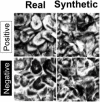The Visual N1 Is Sensitive to Deviations from Natural Texture Appearance
- PMID: 26355681
- PMCID: PMC4565630
- DOI: 10.1371/journal.pone.0136471
The Visual N1 Is Sensitive to Deviations from Natural Texture Appearance
Abstract
Disruptions of natural texture appearance are known to negatively impact performance in texture discrimination tasks, for example, such that contrast-negated textures, synthetic textures, and textures depicting abstract art are processed less efficiently than natural textures. Presently, we examined how visual ERP responses (the P1 and the N1 in particular) were affected by violations of natural texture appearance. We presented participants with images depicting either natural textures or synthetic textures made from the original stimuli. Both stimulus types were additionally rendered either in positive or negative contrast. These appearance manipulations (negation and texture synthesis) preserve a range of low-level features, but also disrupt higher-order aspects of texture appearance. We recorded continuous EEG while participants completed a same/different image discrimination task using these images and measured both the P1 and N1 components over occipital recording sites. While the P1 exhibited no sensitivity to either contrast polarity or real/synthetic appearance, the N1 was sensitive to both deviations from natural appearance. Polarity reversal and synthetic appearance affected the N1 latency differently, however, suggesting a differential impact on processing. Our results suggest that stages of visual processing indexed by the P1 and N1 are sensitive to high-order statistical regularities in natural textures and also suggest that distinct violations of natural appearance impact neural responses differently.
Conflict of interest statement
Figures






References
Publication types
MeSH terms
Grants and funding
LinkOut - more resources
Full Text Sources
Other Literature Sources

